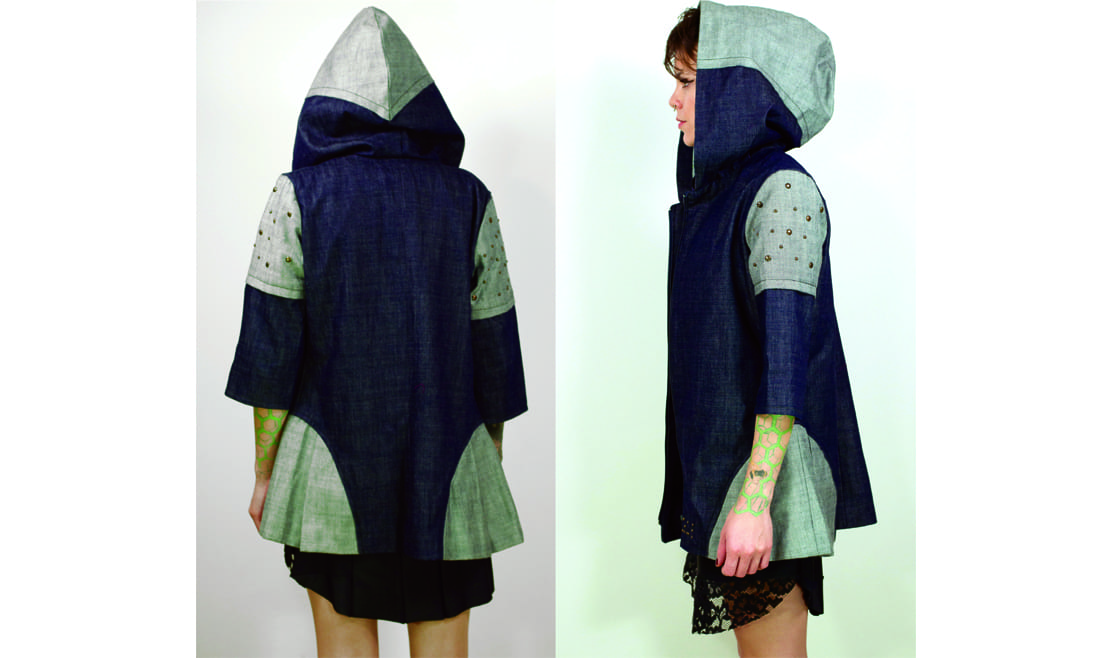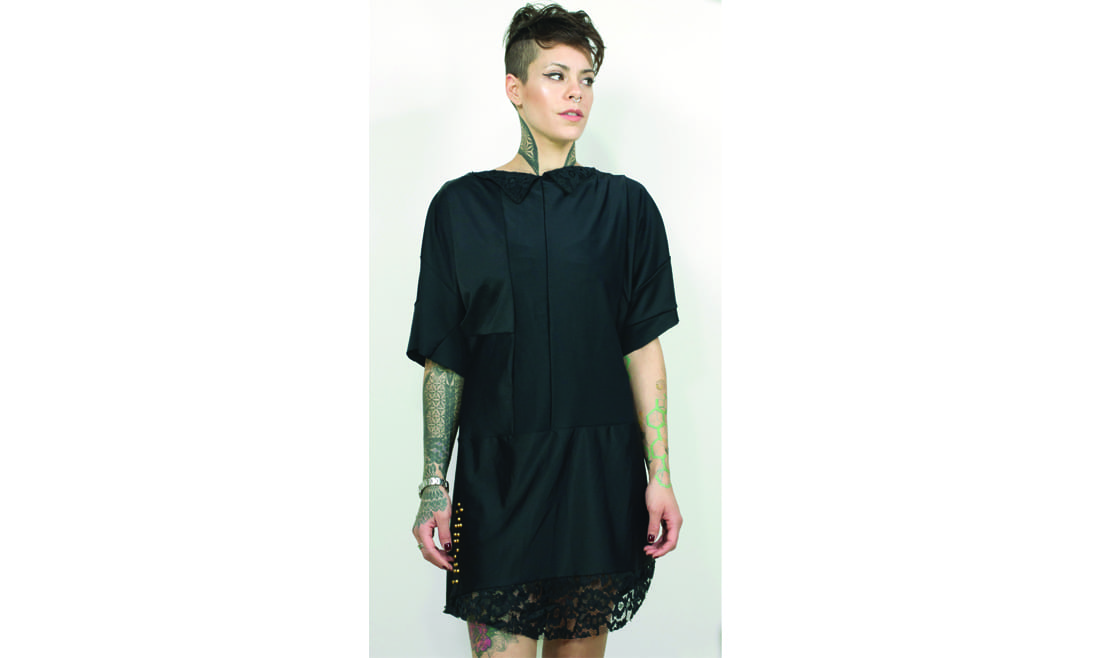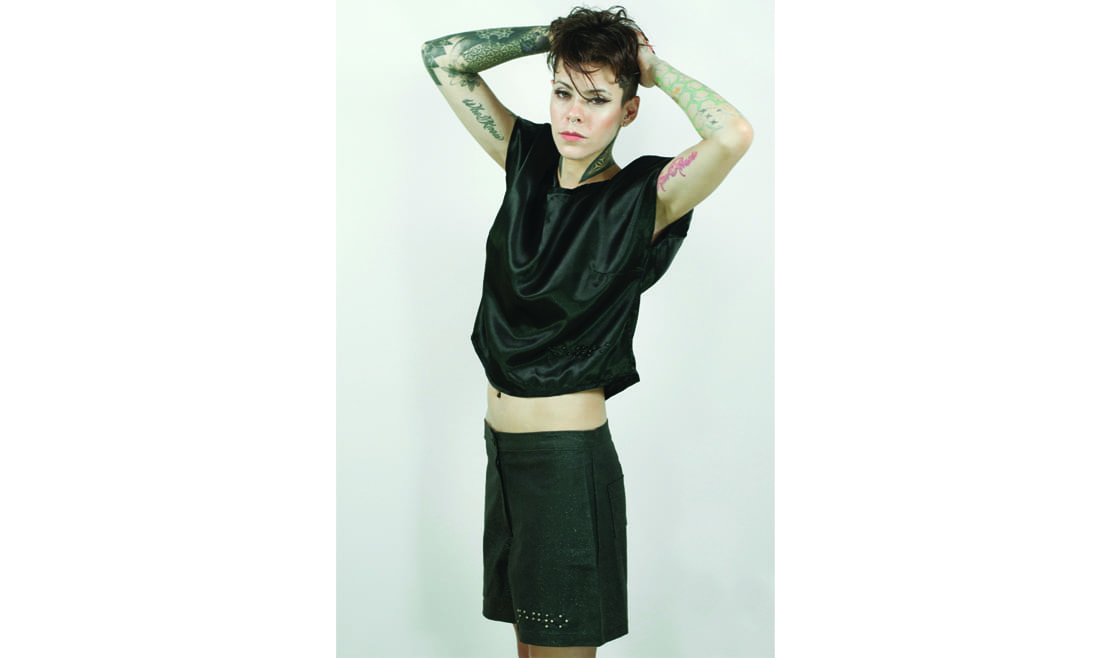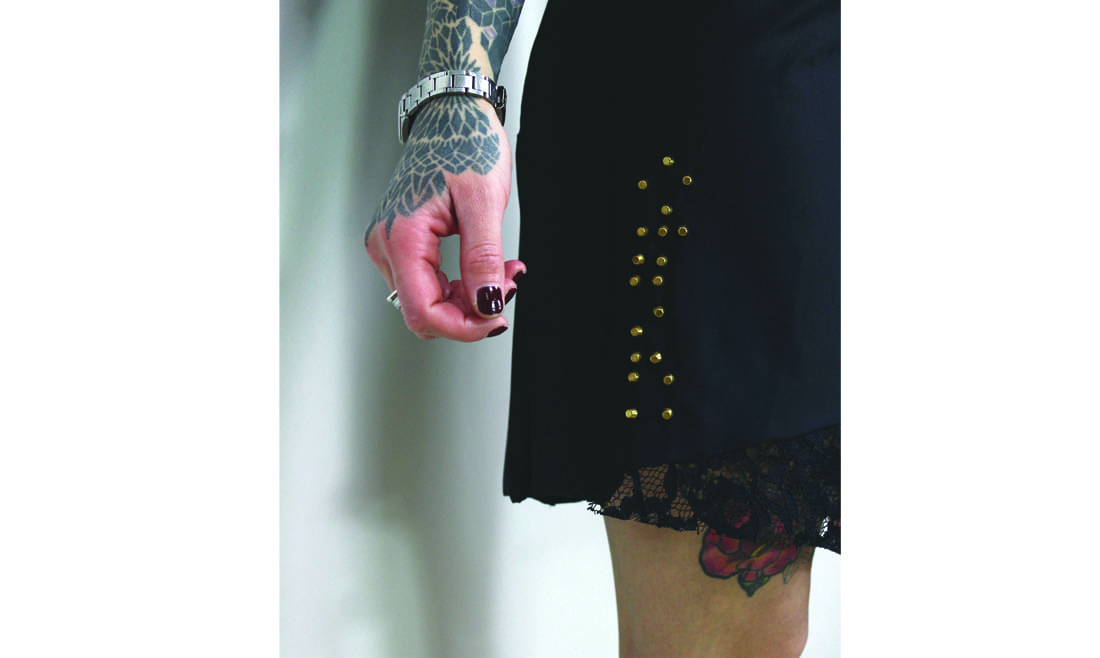María Sol Ungar is a young clothing designer from Neuquén province, Argentina. She graduated four years ago, took her thesis, her few savings and moved to Buenos Aires City to create her own label, Sónar. The uniqueness of this undertaking is that its aim is to include blind people in fashion design, something that is unusual in Latin America. As you may infer, the name comes from the system or ability to locate things by the sound. However, the creator’s point of view is clear: Sónar offers clothes for everyone; it is not just about clothes for the visually impaired.
For instance, the brand’s garments feature special pockets in which to put walking sticks, and textures to be felt easily. For others, this is seen as ornaments as well as a functional space to carry your things around. Moreover, the pieces of clothing have all their labels written in braille and the colour is indicated through embroideries or tacks. As Ungar showed us some of the products, she explained, “Here, a label written in both text and braille didn’t exist. We make them with a material in relief, similar to serigraph”.
Fashion design wasn’t on María Sol Ungar’s plans. “Nevertheless, my grandmother is a couture dressmaker; sewing was always present in my house, and my mother knits. So, I have been surrounded by cloths and threads but it never was part of my dream or projection.” She tried Communication Sciences but did poorly and ended up studying design in Neuquén due to her love for arts and design.
2016 was a great year for Ungar’s project. In July, she was nominated at an entrepreneurs’ contest of the city’s government, called #Potenciate. Then, she was invited to participate at a fashion show in the local Sheraton Hotel. As a result, Sónar became notorious and had some space in the media. Recently, its clothes were featured at a runway show in the International Congress of the International Association of Image Consultants (AICI) held in May in Mexico.
Welum caught up with the designer last week to learn more about Sónar the brand and Ungar.
What is your overview on clothing design?
To my mind, fashion design is closer to a functional aspect than an aesthetic. When I was studying, I was a lot more interested in the function of each design and things that you don’t see at first sight. But when you talk about clothing design in terms of fashion and trends, this has to do with an artistic issue and doesn’t have a function. I feel very strongly that design must have a role, combining both aesthetics and a functional nature. It is also a response to a need.
As a result, I have never been a follower of trends. I don’t like them because it seems to me that they are elitist in the economic sense, as well as physically: they make every person believe that everyone needs something specific and that it fits them equally. And this is not true. For example, I am 1.5 meters tall and if I wear thigh high boots, they would end around my waist. It strikes me that there are a lot of unreal matters around trends, and this new historical epoch where each one follows his/her own trend is excellent. Even though there are some mandates, people create their own look. This is a bit ambiguous for a designer because it opens the field and you have to captivate people for them to find what you do interesting.
What was your motivation to follow your path?
I didn’t use to have blind or visually impaired acquaintances or friends before. I wasn’t close to visual disability but to hypoacusis, autism and Down's syndrome, through my mother’s job as a teacher at a special education school. When I was eleven years old I learnt sign language, which helped me to talk with hypoacusic people and another time, such as whenever I lose my voice, I still can communicate with my mother.
Even though a great part of this perspective on disability was developed thanks to my mother, due to her proximity with people with different types of handicaps, it also was influenced by my father, who is a social and political activist. In a way, they are both activists, always thinking how to improve the quality of life of others. That leads to the thinking that you can become a factor of change, no matter the space you are in at the time. That’s where Sónar comes from: the good lessons received at home.
'I feel very strongly that design must have a role, combining both aesthetics and a functional nature. It is also a response to a need'. María Sol Ungar
How did Sónar begin?
The blindness world was unknown for me and it was brought up when we were outlining the thesis, considering what was still unresolved and what could we do as clothing designers. Disability is not contemplated in clothing design. Garments are normally just adapted, as if disabled people don’t have taste, aesthetic or style. So, I began to look into several types of disability and which I could work on from Neuquén, a place where just recently is widening its textile offering at new stores. The textile industry is almost non-existent there: we still work with dressmakers and small workshops. My first idea was to make clothes with anti-bedsores and perfumed textiles for people with reduced mobility. There was no way that it could be elaborated in Neuquén! It would have meant to mock-up something that couldn’t be applied in my real world.
The thesis implied a complete project for a brand with a store. So, you had to create it from scratch and thoroughly: to carry out a marketing research, create technical datasheets, prototypes, packaging and everything. This led to a nicely-shaped undertaking, starting from a hypothesis that is really the clash between what I think in my visual world and what really happens in the disabled world. For instance, in my view, blind women would have a trouble with a skirt zipper because I need to look at a mirror to zip it up. It was a silly thought.
Then, I arrived at the Special Education School N°7, met a few visually impaired people and started wondering a lot of things. Talking about clothes, they told me that one of the problems were colours. Even though only those who had had the possibility to see before had a notion of colours, others had made an association through touch, taste, smell or a psychological approach (like, red is love or passion). Either they go to stores with someone who assists them, or they ask the colour of the clothes to the people they live with before getting dressed. Now, there are apps that scan garments and tell what colour it is, but it depends on the light and it is not always accurate.
Also, they told me that the seam would have to indicate the inside and out of the piece. And then, I started thinking about other issues, such as creating a 23 cm pocket for jackets and trousers. If a blind person goes dancing, where does he/she leave the walking stick? He/she can’t leave it at the cloakroom nor can dance with it. So, you can fold it, put it inside the pocket, and then take it again. They live with situations when they don’t know what to do with it or where to keep it. And the same happens to us: you have a huge cell phone or wallet and if you don’t have a bag, you don’t know where to carry it.
So, I started to think about adapted garments for both worlds; that were functional and inclusive. For instance, how to indicate the colour of the clothes? Through embroideries made with tacks, paillettes, beads and other materials. It seems like an ornament, but it has also a function.
When I started developing the pieces with new twists, the blind acquaintances I had made gave me some feedback. I was always mentally prepared for the worse. I was entering an unknown world and I was respectful but didn’t know how they would interpret it. Furthermore, the situation implied a deep unknown on my side and an inequality because I am sighted. But, actually, I had a great response.
Why did you uproot yourself and come to the capital?
Firstly, fashion is seen as a faraway scene in Neuquén. Secondly, I came to Buenos Aires because my project was already set up and here there’s the brand registry and legal framework. I wanted to apply to them and investigate more because there were more blind institutions and specialised stuff here.
I arrived with my thesis in my backpack, almost no money and just trying my luck. The process of getting to this point took me four years, to settle in the city and get a job to support myself while I was doing this. The project was stopped for two or three years when I hesitated and thought, How can I compete in the market? Who will care about what I do? and those sort of questions. I was totally alone at first; I had no connections, no one.
There is something real that I intend to have it noticed: I don’t come from a lineage of designers, I am not Martín Churba. I come from a working class family. My mother teaches hypoacusis children and my father is a foreman. I paid for my educational career by working: I attended class, studied, worked and slept five hours a day. My mock-ups were done with whatever I found available.
How could you advance after that?
I remember a particular moment. It’s an image I will never forget and is useful to measure what my effort is worth. I was sitting at a hostel room on the floor, eating and exclaiming, “This will never happen! What on earth am I doing in Buenos Aires?! Why did I come here?!”. During the next day, I made a list of places where there were blind or visually impaired people, put the clothes in a bag and decided to show them and see what happen.
I went to the National Publishing of Audio Books, and other places where I knocked on doors, introduced myself and tried to open spaces and break barriers. At the Argentinean Library for Blind people I met a group of young women who were delighted and they taught me to write in Braille. It was the first time they believed they had a voice in design. We talked about a million of useful ideas and I learned a lot from them. So, I ended up as a library volunteer, now I am one at Tiflolibros (a digital publishing) and I participate on Tiflo-running: I run with blind people, as a guide, on Saturday mornings. These are all experiences that nourish me to think of others and design.
I am Sónar’s designer alongside with an Ecuadorian clothing designer that helps me. Then, there’s a large group of friends that assist me with everything else (graphic designers, photographers, etc). This project is done with a great effort, a product of passion, for my love to disabled people and for the love of my friends to me. We are all betting on this, contributing to the undertaking.
Enlarge
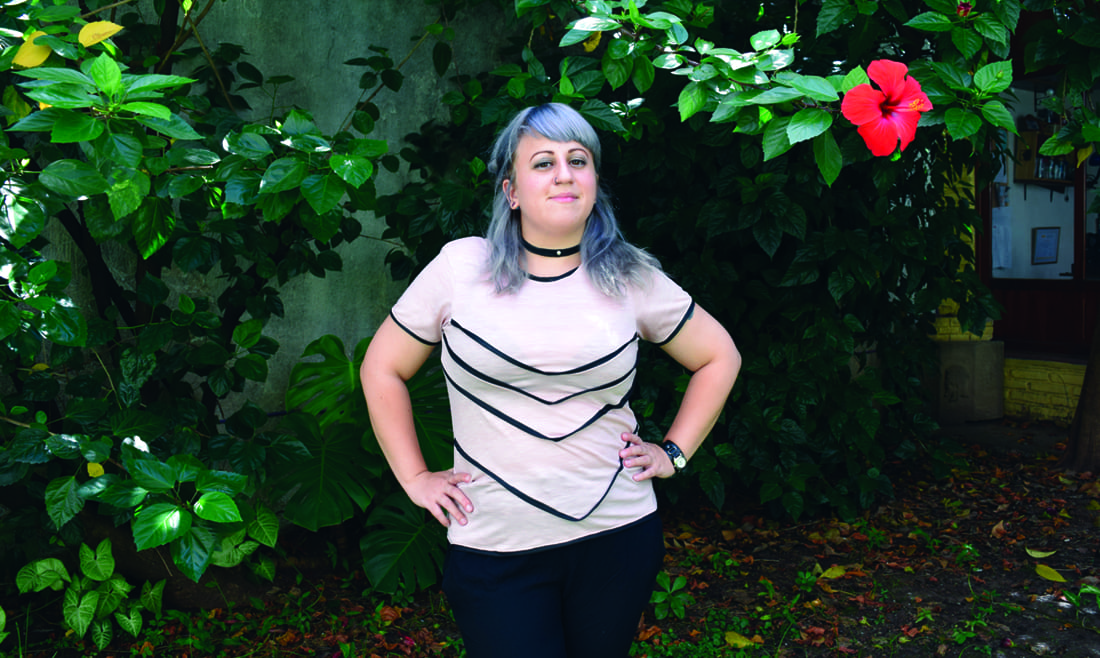
Sónar
What is important about Sónar?
There’s something that I believe it is the most important thing for a brand and has happened to me; this is, when the user appropriates the brand. Besides being profitable, it is extremely important for a designer that the user feels identified with the brand, and that your proposal functions. If your creation is bought, functions and identifies the user; that’s it.
Secondly, it made a noise and grabbed some attention at least in Neuquén, suggesting that not all of the Argentinean design comes from Buenos Aires City. To know that you can’t disregard your work just because you are from the interior of the country. When I was working on my thesis, I had to solve many problems due to my location. You had to come up with a creative solution for many things, which enriches the process and allows people from the interior to think that when something is not available, it means that you have to create it on your own.
Thirdly, this project means to address designers to question themselves about what they do. Do we exit the university and make clothes for commercial brands? Or should we really change people’s lives? Where do we take a stance? The clothes of a bricklayer, a fisherman or a man that works at a meat processing plant comes from design. Someone thought about it. What happens to these people? Why fashion can’t be more functional?
This undertaking is important to establish a dialogue regarding the purpose of design and also what are we doing as consumers. Who are we buying clothes from? It’s important to think what is behind and if you are giving your support to fifty businessmen who have sweatshops with workers packed together. When the moment comes, I would like my brand to have a cooperative workshop, that people can appropriate the label to wear the products as well as contribute to make them. That is not only “a child of mine” but one of many people.
What is the undertaking's stage today?
The project is acquiring the proper form of a business company. At the beginning, when there wasn’t any money for even buying cloths, we would look for everything we had done and re-built pieces from fabric scraps. It was a thesis and a small project until last year. I participated at a Buenos Aires City government contest and Sónar went viral. I was being contacted to do some interviews by the press and I only had four garments, let’s say. So, I hired a workshop and started designing more clothes to create a stock in case I needed it. I was being called from Usuahia to Misiones and I wasn’t ready for either the impact of the articles or the diffusion.
We applied for a Fondo Semilla (Seed Found), a national loan, which is allowing us to buy machines. As a result, we are doing all dressmaking tasks by ourselves: mouldering, selection and purchase of textiles, cut, manufacturing, labels… everything is passing through our hands. Nowadays, we are toying with the iron and create relief and textures.
Anyway, we are setting the workshop up, dedicating ourselves to it: creating new designs and a stock of products. We’re at a growing stage, open to proposals as long as it doesn’t transgress our initial idea: social inclusion in design. I don’t make a living out of it yet, but I live thinking, building and setting up this undertaking. It’s what I like doing and I have a commitment with my visually impaired friends who support me and keep asking me about what I’m doing next. In addition to the pleasure of doing what you like, if it does well to other people; then is great.
What are the criteria you consider when facing the creative process?
I’m looking for some post-modern features. When it comes to design, I tend to use a lot of geometrical forms or morphologies. Personally, I like the street-punk and cyber-punk aesthetics. I’m exaggerating this a bit now. At the beginning of Sonar, designs were more naïve because it was new, so clothes were more elegant and with peaceful colours. Now, we’re taking the image into a rocker concept because we realise that there’s a niche for that sort of garments and that it wasn’t being attended to in Buenos Aires (just like what happens with braille indicators on clothes).
Since I don’t make clothes for disabled people (I make clothes for people), it may show any type of style. Even if it implies a more dramatic look, it complements other pieces to go to work or like a gown, for example. Being casual offers that duality. I pretend for it to be urban and I use noble textiles which are practical in its use, like denim or cotton. From time to time I have the luxury to use a “prettier” fabric.
Moreover, Sonar’s garments toy with tactile features. When I search for textiles, I put emphasis on this, on touching them and see how they feel because blind people enjoy design through this. Each part that changes make them think abstractly about the clothing design.
When it comes to inspiration, I search for geometrical images, fashion designers that I admire architecture and origami. I have a wooden human figure so, when I can’t quite imagine the garment being worn, I create the piece on paper and I dress it, only to break it down afterwards. I have the mind of a designer but I am just a beginner at sewing, so my workmates are guiding me on that matter, saying what can and can’t be done. Finally, when it comes to colour, I take into account the seasons: black for winter, pink for spring and that sort of things.
Enlarge
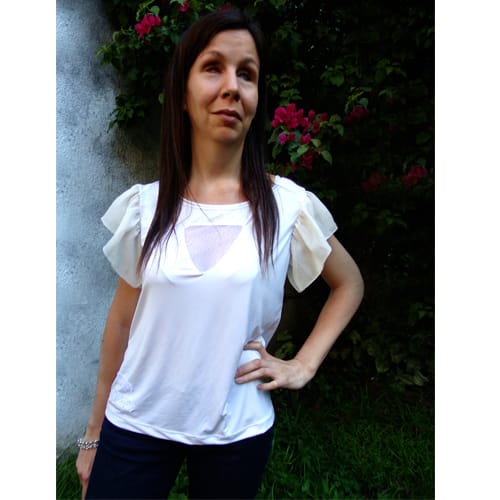
Sónar
How do you get in touch with a blind person’s needs and keep updated on that matter?
Once, a professor from the University of Palermo advised me to keep my project secret (I had just arrived at the city) because there were a lot of “vultures” at that circle. It was really funny. He also suggested soaking up with user's knowledge.
Thanks to the Argentinean Library for Blind people, I met three marvellous women: they are enterprising, break the stereotype and are fashionistas when it comes to dressing. One of them works at the courthouse and knows more about fashion than I do. Other works at Tiflolibros and other at the Library. We got really close and I learnt a lot about their world because I’m really curious. For example, I’m cooking and I ask one of them “Hey, how do you ignite the burner’s fire?” We go running at the Rosedal, which is 1,600 meters long and do approximately five rounds, so we have a lot of time to chat.
Basically, I live on this milieu where I can see everyday life, how they move and consult them. The fact of knowing young, dynamic and interesting people impacts on my undertaking. Most of them are literate which enables us to keep a wonderful exchange in an elaborated language in a wide variety of themes. This allows you an abstraction: to think from another point of view, and maybe end up realising that the world is too visual and comprehend a lot of things from there.
I do this on a personal level as a challenge. In consequence, I don’t see it just as enrichment of the project, but of myself as a person. When you are functional to something in order to help people improve their lives; it makes you feel good, useful and recognised even if no one congratulates you on it. You have to get close to it, absorb that world and make it real. That is why I live with people that have visual disabilities and I continuously learn about it. I would like for this brand to develop clothing for people with reduced mobility and other handicaps.
How did the Mexico runway show came up?
As a volunteer at the National Library and Tiflolibros, the latter invited me to a fashion show at Sheraton Hotel in September of 2016. The event was held by them, and presenters, models and musicians were all visually impaired. After that, I was convened to the Jornadas Coquetas (Coquettish sessions), organised by Tiflonexos and which counted with the participation of Sandy Cornejo from AICI Argentina. These were a series of workshop dictated for disabled people to learn how to dress better, put on some make up themselves, etc. I met Sandy and she invited me to a lecture at a business school in Córdoba. I introduced my undertaking there, a make up artist gave another conference and Andrea (my running mate) exposed her own experience as disabled.
I remained in touch with Sandy and a few weeks ago she called me to participate at a runway show at the International Congress in México. So, in a couple of weeks I rapidly created new garments to meet the deadline. I hadn’t lived those long working days since the design career! It is a huge privilege for me and a unique possibility. AICI contacted me and said that they would like to show my clothes at that event. There was going to be a lecturer on disability and design and they told me that this was the only inclusive proposal present, which was great to interpellate other designers, as said before. And to make some more noise.
'I do this on a personal level as a challenge. In consequence, I don’t see it just as enrichment of the project, but of myself as a person. When you are functional to something in order to help people improve their lives; it makes you feel good, useful and recognised even if no one congratulates you on it'. María Sol Ungar
What are your plans for the future?
I would love to have a Sónar store with our unique proposal, having special mannequins on display. I am making a fusion with a huge tattoo parlour with a studio in Neuquén. They want to use, buy and sell our clothes. This is another niche of people and adds another perspective on our project, seeing how we are accompanying ourselves from “outside the system”.
We are currently developing our own workshop but my idea for the future is to also have a shop and hire disabled people to work in both places. That would mean to create a circuit: they would be customers but also developers. Furthermore, there are many seamstresses and dressmakers that aren’t inserted on the working market, so I would like to give them the opportunity. I want to have a social impact with my brand and try to extend it as much as I can. In other words, to evolve from what we have created today.
Tags
blind / Buenos Aires / clothing / Form / Function / María Sol Ungar / Neuquén / Sónar / Visually impaired
blind / Buenos Aires / clothing / Form / Function / María Sol Ungar / Neuquén / Sónar / Visually impaired

